|
Salome, the biblical girl/femme fatale who danced for her stepfather, Tetrarch Herod, and as a reward, received the head of John the Baptist
on a platter, has inspired legions of creators — in literature (Flaubert), theater (Oscar Wilde), cinema (at least 25 versions), art (Caravaggio, Gustave Moreau), and
opera (Massenet, Richard Strauss q.v.*). Given the famous “Dance of the Seven Veils,” invented by Oscar Wilde in his 1891 stage play Salome: A Tragedy in One Act,
it is amazing that ballet hasn’t jumped on this heroine. I didn’t find much online. A Salome ballet by Danish choreographer Fleming Flindt, in 1978, used the biblical story, as did Demis Volpi last year at the Stuttgart Ballet. Not so Portuguese choreographer Arthur Pita, whose new world première for San Francisco Ballet asks the question, what these mythical people, Herod, his uncouth wife Herodias, dancing girl Salome and their victim, prophet John, would be doing nowadays.
Pita grew up in South Africa, worked in Britain, and is brand-new to the United States. Some of his background is disco dancing. He is a
versatile all-round theater and dance maker, much like his partner, Matthew Bourne, the British choreographer who created the famous all-male Swan Lake. Pita made a
splash in 2011 with a Kafka ballet, Metamorphosis, at the Royal Ballet, and has expended his mixed-genre themes with parts of Brecht’s Three Penny Opera.
“We talk about work a lot,” Pita told The Guardian about his relationship with Bourne, “because we’re both obsessed, but it’s never competitive,
our styles are so different… If you’re talking about influences, Matt goes back to the MGM musical and I’m more David Lynch.”
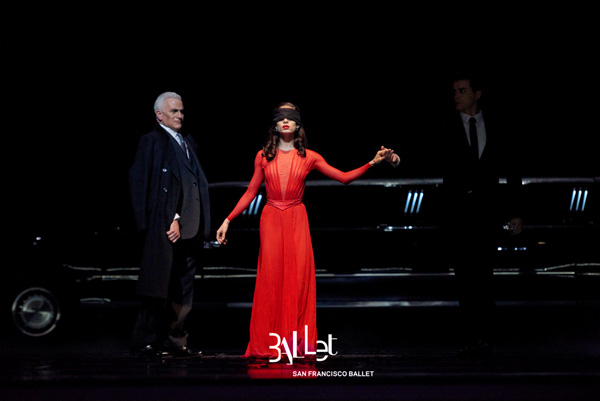
Indeed, the 40-minute Salome Pita envisioned for San Francisco Ballet has all the glamorous elements of a Hollywood movie,
with the surreal touch, adult sexuality and violence that gave Pita the nickname “the David Lynch of dance.” The piece opens
with a scene inspired by the start of Lynch’s Mulholland Drive. A long, black limousine rolls smoothly out of the night onto a
stage covered with mist, triggering laughter of surprise and recognition from the audience. (Stage design and costumes by
Yann Seabra.) But the laughter lasts only a second and never returns. The music by Frank Moon, a British musician and composer for theater and ballet (a frequent collaborator of
Pita’s), is dark and suspenseful like a movie score. Four bodyguards step out of the coffin-like, gleaming luxury sedan,
check the audience, then open the doors for Herod, gentleman in a tux, Herodias in a snake-green evening gown, and finally,
sweet sixteen Salome in a red party dress, her eyes blind-folded. Is she a hostage? Is this going to be some kind of execution? No,
the drive to the location is a birthday surprise, and the ritual of the night begins with a box presented by the henchmen: a tiny
toy cake with a single candle. She blows, and canon shots explode into a firework of confetti from both sides of the stage,
raining like luminous, pink butterflies over the birthday girl. (Lighting design by Jim French) A gleaming flute of champagne
is handed her by Herod: she drinks, slightly totters, is clearly getting high on a drug.
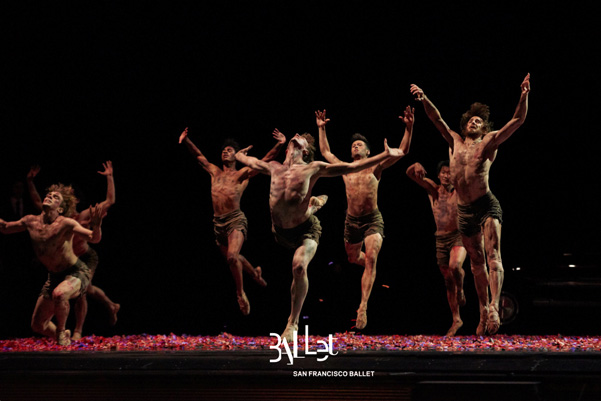
The next step in the coming of age ritual of the girl is another gift, this time in human kind. Seven men, prisoners or hostages,
half naked and hidden under rough cloth “veils” are brought forward to “play” with her. And Salome, not exactly an innocent,
knows how to play. Hauntingly embodied by Spanish Principal Dores Andre, there is giddy excitement and confusion, a cruel
hauteur in her head turns, but also the sheer wonder of erotic discovery. She rips off veil after burlap veil and becomes at moments the trainer of a band of wild dogs.
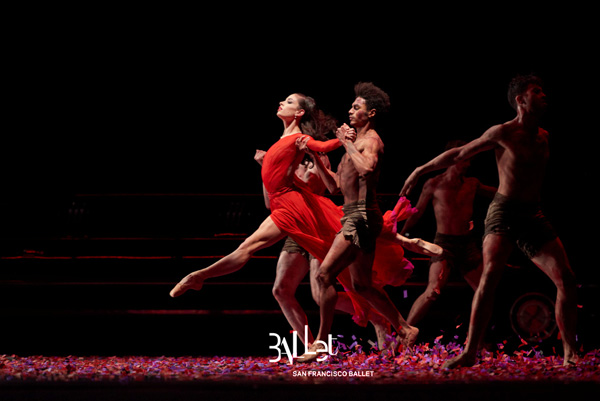
Pita has found the perfect archaic body language for the seven hostages. His vocabulary has soaked up the stomping violence of
Pina Bausch’s Rite of Spring, the twisted limbs of Mats Ek’s Giselle, the earth-bound, partly grotesque moves of Jiri Kilian
and the medieval slouches of Mark Morris. Watching bits of his work on YouTube, you realize he is a creative sponge, absorbing
anything of interest that happens somewhere in the world on a ballet or theater stage. The result, however, has nothing
borrowed. The seven hostages, danced by top dancers of the company, launch into a coherent, utterly convincing archaic
wildness, equally evocative of ancient Hebrew war rites as of modern, edgy moods of torment and violent desire. Every now
and then, in step with the beat and gun-fire rat-tat-tat of the score, another canon shot goes off with an orgiastic burst of
confetti, now dangerously red like swarming clouds of locusts. While the stage thickens with paper refuse, the dance goes on,
growing the suspense of what is truly happening in this bizarre party game. A gang rape as a coming of age ritual?
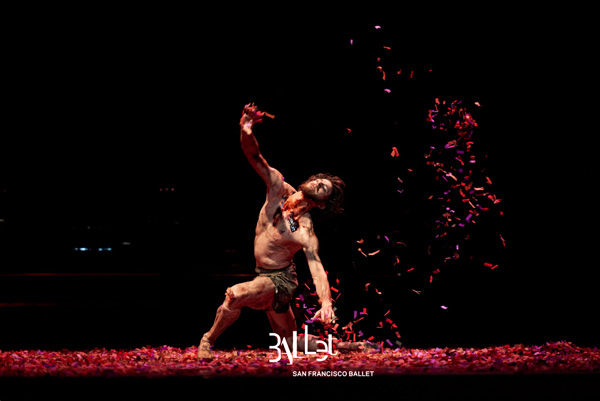
Intense shifts of power between the girl and the men leave you in the grip of alarm and mystery, until Herodias steps in and
marks one of the men as the chosen one. Now Salome is alone with John in what becomes a Roman arena where gladiators
fight for their life against a wild beast. Only, while the elegant parents (Character Dancers Val Caniparoli and Anita Paciotti)
are watching and the guards are part of Salome’s audience, it’s unclear for a time which of them is the wild beast.
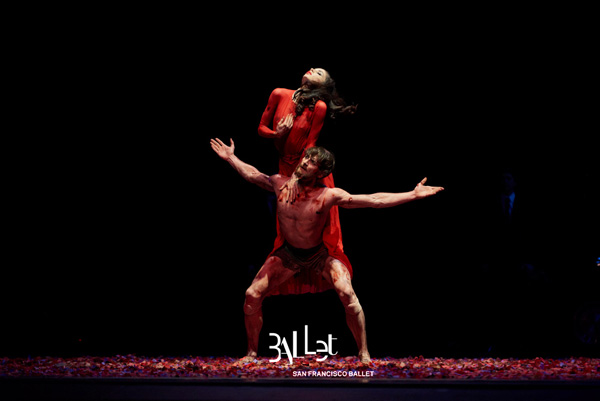
John, danced with explosive energy and superb mastery by the new Principal, British dancer Aaron Robison, refuses the come
-on of the girl, who is highly aroused by now. She wants her adult experience, and she does everything to get it from the man
who picks her up and tosses her away like a toy, but her fierce insistence is like a glue he can’t pull off his body. His resistance
and her insistence perfectly translate Oscar Wilde’s play, and from here until almost the end, Pita follows the play.
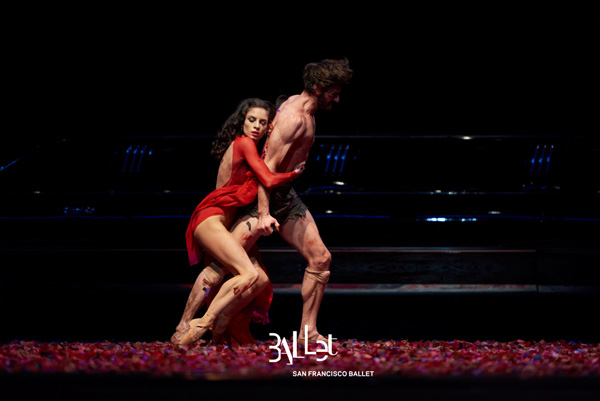
Salome’s desire “I will kiss your lips, John the Baptist…” turns
into a threat with John’s refusal: the henchmen step up behind him with a garotte and drag him away. Now the ominous platter
arrives, carried by Herodias, who sets it down center stage, up front, covered by the rough cloth, and Salome is left alone with
her trophy. As in Strauss’s opera, she takes her time circling it, curious, getting closer until she lies down, and lifts the cloth. She
kisses the lips of the severed head and discovers “the bitter taste of love.”
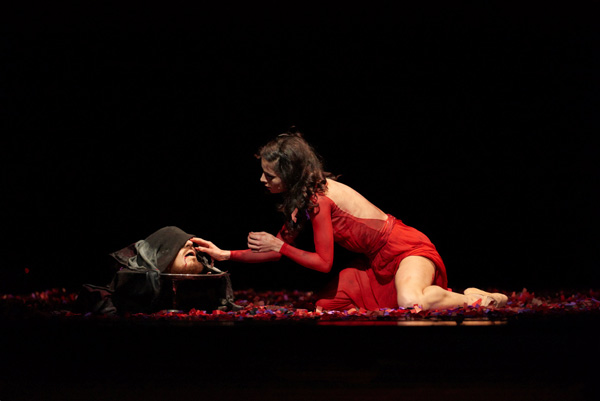
In Pita’s version, the girl is not killed by her suddenly disgusted stepdad. She grabs the head by the hair, lifts it and turns toward
the limousine. The way this Salome, Dores Andre, walks back to the car shows all the emotions of having gone through a rite of
passage: the bleak come-down from a high, an adult awareness of a triumph, and the stubborn, spoiled childishness that insists, This is mine, my toy, and you can all go to hell. The limo door
opens, she gets in, the curtain falls.
This accomplishment puts Dores Andre, who used to stand out for quick-silver speed and energy, in the league of serious dancer
actresses. Only recently made a Principal Dancer, she told the Huffington Post that what helped her tackle the role was the
thought of President Trump: “For me, it’s like talking about a cartel – not necessarily a Mexican cartel. It’s made me think of
Trump and the whole weirdness between him and his daughter.”
Whether or not the audience caught on to contemporary politics, it was obvious in the tense silence that everybody was on the
edge of their seats. Then, a storm of applause seemed to embrace much more than the superb dancers. It embraced Pita,
the fascinating new storyteller and his daring, adult take on the biblical story. And it extended enthusiastically to Helgi
Tomasson, San Francisco Ballet’s director who commissioned this outlandish and outstanding world premiere. Tomasson
called this 5th Program “Contemporary Voices.” He framed Salome with two reprisals by the young, international
choreographers he champions: Yuri Possokhov’s 2008 Fusion, and Liam Scarlett’s recent Fearful Symmetries (qv**). San
Francisco can call itself lucky with this direction toward not just contemporary and provocative creations by choreographic
youngsters, but with the larger scope Tomasson has in mind of extending ballet toward multimedia dance theater productions of world class rank.
Notes:
*Salome with Karita Mattila at the Met http://www.scene4.com/archivesqv6/nov-2008/html/renatestendhal1108.html
** Fearful Symmetries reviewed http://www.scene4.com/archivesqv6/2016/mar-2016/0316/renatestendhal0316.html
Watch YouTube teaser of Salome: http://www.scene4
.com/archivesqv6/2016/mar-2016/0316/renatestendhal0316.html
Photos - Erik Tomasson
|
|